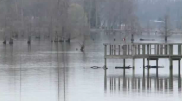Fukushima Power Plant Accident: A Brief History
After a violent earthquake shook Japan on March 11, 2011, nuclear reactors at a power plant maintained by Tokyo Electric Power Company became unstable.
An administrator at the Tohoku Electric Power Co.'s Onagawa facility said the process for the cooling reactor was "not going as planned," adding that "nuclear emergency situation" has been declared. Officials evacuated the three-kilometer area around the plant.
Radioactive steam was released on the second day, however the Fukushima 1 unit eventually exploded, killing four workers.
Multiple explosions occurred on March 14 and 15 with rising levels of radiation. The evacuation area was increased to a 20 kilometer area around the plant.
On March 20, radiation levels begin to stabilize. In an effort to cool the plant, four helicopters dropped water over the Fukushima plant.
The FDA banned imported food from Japan, as it had been contaminated by radiation.
The fact that radiation releases are approaching the level they did in Chernobyl is a cause for concern, a sign of the severity of the accident that's already taken place.
TEPCO president, who had rarely been seen during the disaster response, was rumored to have committed suicide, however it was eventually revealed that he had been hospitalized due to high blood pressure.
By April 2, TEPCO dumped 11,500 tons of radioactive water into the Pacific Ocean. Japan's foreign minister maintains that it posed "no significant health threats" to humans.
On April 12, Japanese officials raised the severity rating of the disaster to 7, the highest possible on the international nuclear event scale. Even so, officials announced that the radiation released amounted to one-tenth of what Chernobyl produced.
Experts suggest that the situation may not be under control for at least two to three months.
Although Japan had declined extensive help from the U.S., Secretary of State Hillary Clinton visited Japan on April 16 to boost their alliance and also assess Japan's response to the disaster.





